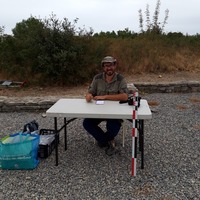
Benoit Favennec
Docteur de l'Université de Montpellier 3 / Paul-Valéry
Thèse/Thesis : Les ateliers de potiers durant l’Antiquité tardive dans les Gaules (IVe - VIe s. ap. J.-C.) / Potters workshops during the late Antiquity in the Gauls (IVth - VIth s AD)
Soutenue le 24 juin 2016 devant le jury de S. MAUNE (directeur), M. JOLY (co-directrice), F. LAUBENHEIMER (rapporteur et présidente du jury), M. BONIFAY (rapporteur) et de P. VAN OSSEL (examinateur)
N'hésiter pas à me contacter pour toutes questions ou demandes d'aide sur les ateliers de potiers et de tuiliers d'époque antique, plus anciens et récents (outils et structures).
Je travaille également sur les structures portuaires de Narbonne avec C. Sanchez (CNRS, UMR 5140) et de Lattara sous la direction de G. Piquès (CNRS, UMR5140) / I work on the harbour of Narbonne with C. Sanchez (CNRS, UMR 5140) and on the harbour of Lattara supervised by G. Piquès (CNRS, UMR5140).
Phone: 06-75-41-17-85
Address: Institut National de Recherches Archéologiques Préventives
Direction Interrégionale Midi-Méditerranée
561, rue Etienne Lenoir – Km Delta – 30900 Nîmes
Thèse/Thesis : Les ateliers de potiers durant l’Antiquité tardive dans les Gaules (IVe - VIe s. ap. J.-C.) / Potters workshops during the late Antiquity in the Gauls (IVth - VIth s AD)
Soutenue le 24 juin 2016 devant le jury de S. MAUNE (directeur), M. JOLY (co-directrice), F. LAUBENHEIMER (rapporteur et présidente du jury), M. BONIFAY (rapporteur) et de P. VAN OSSEL (examinateur)
N'hésiter pas à me contacter pour toutes questions ou demandes d'aide sur les ateliers de potiers et de tuiliers d'époque antique, plus anciens et récents (outils et structures).
Je travaille également sur les structures portuaires de Narbonne avec C. Sanchez (CNRS, UMR 5140) et de Lattara sous la direction de G. Piquès (CNRS, UMR5140) / I work on the harbour of Narbonne with C. Sanchez (CNRS, UMR 5140) and on the harbour of Lattara supervised by G. Piquès (CNRS, UMR5140).
Phone: 06-75-41-17-85
Address: Institut National de Recherches Archéologiques Préventives
Direction Interrégionale Midi-Méditerranée
561, rue Etienne Lenoir – Km Delta – 30900 Nîmes
less
Related Authors
Casa de Velázquez — Publications
Casa de Velázquez
Yann Codou
CEPAM - Université de Nice
pascal capus
Musée Saint Raymond, Musée Des Antiques De Toulouse
Laurent Bruxelles
INRAP, Institut National de Recherches Archéologiques Préventives
Laurent Verslype
UCLouvain (University of Louvain)
Cyprien Mureau
CNRS- Universite de Montpellier
Maxime SCRINZI
Mosaïques Archéologie SARL
InterestsView All (8)










Uploads
Thesis Chapters by Benoit Favennec
Depuis le XXe siècle, les archéologues et les historiens se sont intéressés à l’emplacement des sites, aux structures et aux hommes spécialisés dans la production de céramiques et de matériaux de construction en Gaule. Les sources sont diverses : textes anciens, épigraphie, iconographie, comptes rendus des interventions sur les structures de production et études de mobilier.
L’ensemble des données pour les IVe, Ve et VIe siècles a été rassemblé au cours de ce travail de cinq ans et demi,. Une base informatique a notamment été construite pour définir les ateliers et les zones de productions avérés, incertains ou mal datés, en activité en partie ou sur toute la période étudiée (2055 notices). Par ailleurs, une synthèse sur l'artisanat potier et tuilier pour l'époque antique a été réalisée.
L’argile et le bois, ainsi que la proximité de grandes voies de communication sont des éléments décisifs pour comprendre l’installation et l’évolution de la plupart des ateliers. Néanmoins, d’autres facteurs interviennent : la présence de réseaux de négociants, la vitalité et l’évolution économique et politique de la région lors de l’implantation de l’atelier, ainsi que le statut des terrains d’installation et parfois des mesures législatives.
Les structures artisanales et les techniques utilisées demeurent classiques sur les trois siècles étudiés. Toutefois, l’évolution de l’économie et de la consommation céramique entraine la diminution des dimensions des aménagements. De même, certaines structures sont désormais plus souvent utilisées, tandis que les fours, certains supports de soles, auparavant rares ou inédits, ont pu être mis en évidence. Certaines techniques de façonnage et de décoration, ainsi que des modèles de cuisson deviennent également plus courants.
La densité des ateliers souligne l’importance et l’évolution politique et économique des régions au cours des siècles étudiés. La vitalité ou le déclin de l’artisanat céramique dans certaines régions coïncide ainsi avec les déplacements des points stratégiques de l’économie et du pouvoir politique en Gaule.
(Attention le document en prévisualisation sur https://hal.science/tel-02518633/document ou https://theses.hal.science/tel-01397659v1 peut être relativement long).
---------------------------------------------------------------------------------------------------
Abstract
From the XX century, archaeologists and historians have been interested by the setting of archaeological sites, the structures and the people who specialised in the production of ceramics and tiles in Gaul. There are diverse sources : ancient texts, epigraphy, iconography as well as excavations reports, and the study of ceramics objects.
Data for the IV to the VI centuries has been collated and studied during the realization of this thesis over five and a half years. A database was created to define the workshops and known productions areas, as well as those which are less well known or less well dated but which were at least partly active during the period studied. The database is composed of around 2055 records.
The availability of clay and wood and the proximity of a navigable water course or a network of roads are clearly decisive factors in the setting of each workshop. However there are a number of other important factors: An active network of merchants, a positive economic and political context and sometimes regional or local legislation.
The traditional artisanal structures and technics used remain unchanged between the IV-VI centuries. Overall, the evolution of the economy and the consumption of ceramics leads to a reduction in the size of these structures. Also the use of certain structures becomes more frequent. The kilns and supports for the soles, and ancillary structures, which are infrequently recorded and poorly understood, are discussed in this thesis. Certain technics and styles of fabrication and decoration become increasingly common.
The density and frequency of the workshops underlines their economic and political importance and the evolution of the regions over the three centuries studied. The growth or decline of the ceramic production in some areas coincides with shifts in the centres of economic and political power in Gaul.
(Watch out for the preview document on https://hal.science/tel-02518633/document or https://theses.hal.science/tel-01397659v1 may be relatively long).
Articles / Papers by Benoit Favennec
Dans le cadre d’un projet doctoral, deux zones d’étude en Gaule méridionale occupées à la transition entre le changement d'ère et l’Antiquité tardive ont été sélectionnées. L’étude archéologique et anthracologique des ateliers d’Embournière (Neffiès,Hérault) et de Las Cravieros (Fanjeaux, Aude), dont l’interprétation des résultats s’appuie sur des données obtenues pour d’autres sites contemporains proches, nous amène à proposer une estimation des besoins en combustible, des surfaces boisées exploitées et de leur localisation.
ainsi que de nombreux aménagements, chaines opératoires, productions, et même une partie des aires de diffusion. Le croisement des données de terrain et de laboratoire avec l’expérience d’artisans actuels, des remises en situation et les sources tardo-antiques est aussi éclairant pour la compréhension du site et de son fonctionnement. Trois des cinq artisanats recensés concernent les arts du feu. Ce sont les mieux documentés. Le
plus important et le mieux renseigné est celui dédié au travail de l’argile. Une activité de forge et une autre relative aux préparations culinaires ont pu être aussi assez bien appréhendées, mais leur importance paraît plus modeste.
Abstract: The site of La Garanne in La Fare-les-Oliviers (Bouches-du-Rhône) is an important villa founded in the early 1st c. AD at the edge of the Arc River. Known since the XIXth c., it was partly studied following an excavation in 2009 and 2010 during a project of development led archaeology. This work has documented part of the pars urbana and rustica. The latter is particularly marked by the installation of a potter's workshop and tile makers during the 3rd c. and the beginning of the 4th c. After contextualizing the crafsmanship, the study will focus on presenting the remains of the kiln, then the production assemblage.
Abstract: From the Cevennes to the Mediterranean, across limestone hills and coastal lagoons, the valley of the Vidourle takes in all the features of the lower Languedoc geo-system. This 800 km² catchment area has benefited various walking surveys, programmed and preventive excavations operations that nourish a rich corpus of hundreds settlements. If land use of this valley remains well perceived, the issue of potter and tile maker crafts during antiquity is a field of study barely treated, certainly because of the weakness of the data, compared to the Aude, Herault and Rhone valleys. However, the last ten years have seen the discovery of four kilns, which, together with surveys data, lets you sketch a first synthesis on the production of ceramics and architectural terracottas in the valley.
Drafts by Benoit Favennec
Depuis le XXe siècle, les archéologues et les historiens se sont intéressés à l’emplacement des sites, aux structures et aux hommes spécialisés dans la production de céramiques et de matériaux de construction en Gaule. Les sources sont diverses : textes anciens, épigraphie, iconographie, comptes rendus des interventions sur les structures de production et études de mobilier.
L’ensemble des données pour les IVe, Ve et VIe siècles a été rassemblé au cours de ce travail de cinq ans et demi,. Une base informatique a notamment été construite pour définir les ateliers et les zones de productions avérés, incertains ou mal datés, en activité en partie ou sur toute la période étudiée (2055 notices). Par ailleurs, une synthèse sur l'artisanat potier et tuilier pour l'époque antique a été réalisée.
L’argile et le bois, ainsi que la proximité de grandes voies de communication sont des éléments décisifs pour comprendre l’installation et l’évolution de la plupart des ateliers. Néanmoins, d’autres facteurs interviennent : la présence de réseaux de négociants, la vitalité et l’évolution économique et politique de la région lors de l’implantation de l’atelier, ainsi que le statut des terrains d’installation et parfois des mesures législatives.
Les structures artisanales et les techniques utilisées demeurent classiques sur les trois siècles étudiés. Toutefois, l’évolution de l’économie et de la consommation céramique entraine la diminution des dimensions des aménagements. De même, certaines structures sont désormais plus souvent utilisées, tandis que les fours, certains supports de soles, auparavant rares ou inédits, ont pu être mis en évidence. Certaines techniques de façonnage et de décoration, ainsi que des modèles de cuisson deviennent également plus courants.
La densité des ateliers souligne l’importance et l’évolution politique et économique des régions au cours des siècles étudiés. La vitalité ou le déclin de l’artisanat céramique dans certaines régions coïncide ainsi avec les déplacements des points stratégiques de l’économie et du pouvoir politique en Gaule.
(Attention le document en prévisualisation sur https://hal.science/tel-02518633/document ou https://theses.hal.science/tel-01397659v1 peut être relativement long).
---------------------------------------------------------------------------------------------------
Abstract
From the XX century, archaeologists and historians have been interested by the setting of archaeological sites, the structures and the people who specialised in the production of ceramics and tiles in Gaul. There are diverse sources : ancient texts, epigraphy, iconography as well as excavations reports, and the study of ceramics objects.
Data for the IV to the VI centuries has been collated and studied during the realization of this thesis over five and a half years. A database was created to define the workshops and known productions areas, as well as those which are less well known or less well dated but which were at least partly active during the period studied. The database is composed of around 2055 records.
The availability of clay and wood and the proximity of a navigable water course or a network of roads are clearly decisive factors in the setting of each workshop. However there are a number of other important factors: An active network of merchants, a positive economic and political context and sometimes regional or local legislation.
The traditional artisanal structures and technics used remain unchanged between the IV-VI centuries. Overall, the evolution of the economy and the consumption of ceramics leads to a reduction in the size of these structures. Also the use of certain structures becomes more frequent. The kilns and supports for the soles, and ancillary structures, which are infrequently recorded and poorly understood, are discussed in this thesis. Certain technics and styles of fabrication and decoration become increasingly common.
The density and frequency of the workshops underlines their economic and political importance and the evolution of the regions over the three centuries studied. The growth or decline of the ceramic production in some areas coincides with shifts in the centres of economic and political power in Gaul.
(Watch out for the preview document on https://hal.science/tel-02518633/document or https://theses.hal.science/tel-01397659v1 may be relatively long).
Dans le cadre d’un projet doctoral, deux zones d’étude en Gaule méridionale occupées à la transition entre le changement d'ère et l’Antiquité tardive ont été sélectionnées. L’étude archéologique et anthracologique des ateliers d’Embournière (Neffiès,Hérault) et de Las Cravieros (Fanjeaux, Aude), dont l’interprétation des résultats s’appuie sur des données obtenues pour d’autres sites contemporains proches, nous amène à proposer une estimation des besoins en combustible, des surfaces boisées exploitées et de leur localisation.
ainsi que de nombreux aménagements, chaines opératoires, productions, et même une partie des aires de diffusion. Le croisement des données de terrain et de laboratoire avec l’expérience d’artisans actuels, des remises en situation et les sources tardo-antiques est aussi éclairant pour la compréhension du site et de son fonctionnement. Trois des cinq artisanats recensés concernent les arts du feu. Ce sont les mieux documentés. Le
plus important et le mieux renseigné est celui dédié au travail de l’argile. Une activité de forge et une autre relative aux préparations culinaires ont pu être aussi assez bien appréhendées, mais leur importance paraît plus modeste.
Abstract: The site of La Garanne in La Fare-les-Oliviers (Bouches-du-Rhône) is an important villa founded in the early 1st c. AD at the edge of the Arc River. Known since the XIXth c., it was partly studied following an excavation in 2009 and 2010 during a project of development led archaeology. This work has documented part of the pars urbana and rustica. The latter is particularly marked by the installation of a potter's workshop and tile makers during the 3rd c. and the beginning of the 4th c. After contextualizing the crafsmanship, the study will focus on presenting the remains of the kiln, then the production assemblage.
Abstract: From the Cevennes to the Mediterranean, across limestone hills and coastal lagoons, the valley of the Vidourle takes in all the features of the lower Languedoc geo-system. This 800 km² catchment area has benefited various walking surveys, programmed and preventive excavations operations that nourish a rich corpus of hundreds settlements. If land use of this valley remains well perceived, the issue of potter and tile maker crafts during antiquity is a field of study barely treated, certainly because of the weakness of the data, compared to the Aude, Herault and Rhone valleys. However, the last ten years have seen the discovery of four kilns, which, together with surveys data, lets you sketch a first synthesis on the production of ceramics and architectural terracottas in the valley.
Nouvelles données concernant l’établissement rural antique repéré par A. Michelozzi en 1987-1988
Cette journée des équipes TP2C et TeSAM de l'UMR5140, est aussi soutenue également par le Labex Archimède et l'INRAP.
A noter qu'il existe aussi la possibilité d'assister à la journée par visioconférence via Microsoft Teams. Pour ce faire, une demande d'inscription est à adresser à bfavennec@gmail.com. Le lien sera envoyé la veille et/ou le matin de la journée d'étude.
Samedi 9 décembre 2017. Entrée libre dans la limite des places disponibles.
far. An inventory was realized, based on a broad range of activities (ceramic, charcoal, lime, vegetal exudates, food, metal, glass, textiles, leathers, soap, salt, plaster) gathered in a same data basis. In order to understand phenomenon of rupture and continuity of the practices, the corpus comprises a chronology going from the Romanization to the Industrial Revolution. Craft and industry constitute the major part of the corpus. This work raises new questions. Currently, archaeologists aim to link the use of fuel with
the type of products made (ceramic, lime, glass, etc.). Also, they affirm that some taxa have a calorific value more important than others, and that craftsmen used to chose the fuel regarding its specific properties. Nonetheless, our research proves that these ideas are not representative of past practices. For this reason, we propose a new approach which takes into account the
constraint imposed by thermic and technical necessities (i.e. concentration of fire, or, on the contrary, circulation of fire in the kilns). Indeed, the choice of fuel does not always rely on the choice of a taxa for itself but on other criteria such as morphology, caliber, humidity level, etc. Furthermore, we propose a different interpretation of anthracological data. Generally, anthracologists
consider that their data only reflect the choice of the craftsmen and the ecological constraints. But it appears that the role of land/forest owners, who managed the fuel resources, has never really been discussed or taken into account. This communication will propose a first discussion on the subject. Studies of multi-craft sites will be presented, as well as examples of “gestion sur pied”
(distribution of elements coming from a same tree in order to fuel different activities). Recent methodological developments will be introduced, such as the restitution of calibers, or the observation of tools marks, bringing information on the preparation of the fuel. By crossing anthracological data with medieval and modern texts, a socio-professional approach of the preparation of the fuel will also be possible. At last, the energetic transition towards the use of fossil charcoal will also be attempted.
https://ciencias.ulisboa.pt/sites/.../Leveque-H2O_corrected.pdf